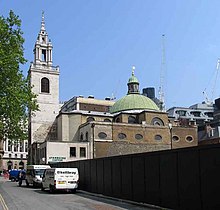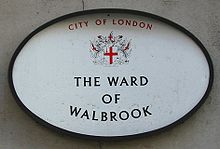Walbrook
Walbrook is the name of a street and a - today underground - brook in London . Both are in the City of London , the historic center of the city.
Waters
The Walbrook played an important role especially in the middle of the 1st century, during the establishment and settlement of Londinium by the Romans . It originated at Finsbury , flowed through the walled city area and finally flowed to the Thames . Its mouth was roughly at what is now the Cannon Street Railway Bridge at Walbrook Wharf . The watercourse thus divided the Roman city in two halves, at that time it was probably used primarily for the supply of drinking water and for the discharge of sewage. The Romans built a Mithras temple on its eastern bank, the remains of which were rediscovered during construction work in 1954. The residence of the Roman governor once stood near its mouth and also on the east bank. The stream itself was built over in the 17th century; since then the Walbrook has flowed entirely underground.
Street
The current street, which was named after the Walbrook, runs parallel to the former stream. St Stephen Walbrook's Church is located here . Its predecessor from the Anglo-Saxon period was on the west bank. The new building on the east bank was built around 1439. However, this was destroyed again in 1666 in the Great Fire of London . Under the direction of Christopher Wren , a new church was built by 1672, which still exists today.
exploration
In the 1860s excavations took place along the road under the direction of General Augustus Pitt Rivers . The archaeologists found a large number of human skulls in the streambed; however, other parts of the skeleton were hardly present. The find was reminiscent of a story from the Historia Regum Britanniae by Geoffrey of Monmouth , according to which a renegade Roman legion had surrendered to the troops of Asclepiodotus , whose soldiers were then executed and their severed heads thrown into the stream. Geoffrey's history, however, is largely unhistorical. Today, research suggests that the skulls came from victims who perished during the destruction of the city in the wake of the events of the Boudicca uprising .
In 2016, when a new high-rise office building was being built, wooden plaques were found in the damp mud of the former river, which represent the oldest handwritten documents in Great Britain. Of a total of 405 tablets, 87 could be deciphered. They give an insight into everyday life in the city in the time of the first century AD. A plaque from the year 43 AD provides the oldest mention of the Roman name Londinium for the city. Most of the plaques were found in layers of rubbish that had been brought to the site to fortify the banks of the river.
See also
Remarks
- ^ Lewis Thorpe: The History of the Kings of Britain . Penguin Books, 1973. ISBN 0-14-044170-0
- ^ John Morris: Londinium - London in the Roman Empire . Weidenfeld & Nicholson, 1982, p. 111. ISBN 0-297-78093-X
- ↑ Maev Kennedy, Oldest handwritten documents in UK unearthed in London dig in: The Guardian , June 1, 2016, accessed June 2, 2016
Coordinates: 51 ° 30 ′ 45 " N , 0 ° 5 ′ 26.2" W.

